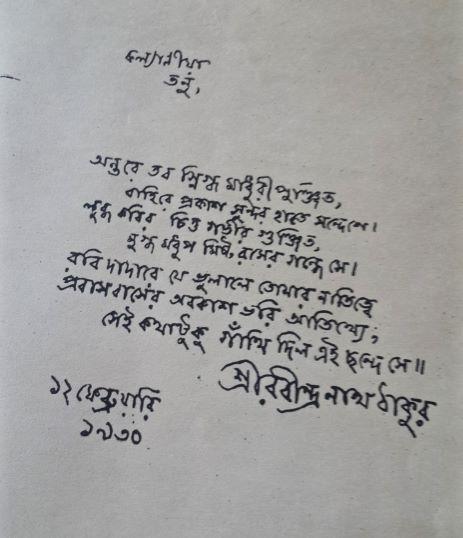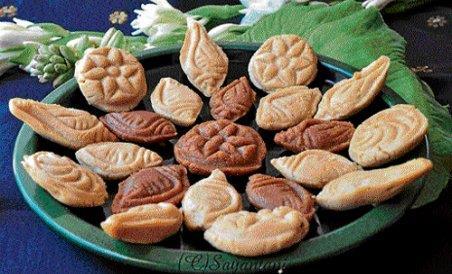
On Sandesh, the iconic Bengali sweetmeat
(MENAFN- NewsIn.Asia) By Dr. Lopamudra Maitra Bajpai/newsin.asia
One of the very first verses written by a very young Rabindranath Tagore was on Sandesh, a popular sweetmeat made of cottage cheese.
Amsotto dudhey feli,
tahatey kodoli doli
Sandesh makhia diya tatey…
Hapush-hupush shobdo,
charidik nistobdho
Pinpra kandiya jay patey
(Mix aam papad in milk, along with mashed banana and sandesh. Relish and eat. The poor ants would return in vain)
The sweet-smelling mishmash is relished with generous slurps till the bowl is emptied, so fully, that even ants would not have anything to left to savour. In later years, Tagore's literary club 'Khamkheyali Sabha' was as famed for its high tea as it was for its thoughts. Known to nurse a soft spot for 'macch' (fish) and 'mishti' (sweets), including Sandesh, Tagore alludes to the sweet dish in a letter to Tanuja Devi, renowned for her culinary skill. The letter was published in Tanuja Devi's 1949 book 'Panch-Mishali'. Dated February 12, 1930, Tagore said in his letter that he was extremely happy to have savoured the wonderful Sandesh prepared by her.
A native of Bengal, Sandesh is the pride of West as well as East Bengal (now Bangladesh). In both Bengals, Sandesh has a fascinating array of flavours, shapes and sizes. Though it is an important part of popular culture, the paucity of historical references makes tracing its past difficult. Available data are few and scattered, and the material covers only the last two centuries. Thus, Tagore's allusions to Sandesh made more than a century back, assume significance.
Sweetmeats from West Bengal and Bangladesh were once confined to domestic kitchens. But with the passage of time, most of them found their way to the shelves of sweetshops as more and more people found less and less time to make many of those sweetmeats at home. Sandesh, is one such sweetmeat.
Made from soft and supple cottage cheese or paneer, this simple sweetmeat has grown to reflect varied ideas. They now are an eclectic mix of the past and the present. Experiments on Sandesh making are constantly made with the result there is an amazing array of different shapes, sizes and tastes.
Adding to this are the variety of casts for making Sandesh. These casts called 'chhanch' in Bengali, used to be made from terracotta, stone, wood, or metal. A close study of the casts reveals that they are centrifugal as the designs emerge from the centre to reach the border. The shapes can be round, triangular, oval or a combination of them. The motifs on the casts create both symmetrical and asymmetrical designs, but always keeping to the central focus of the motif.

Rabindranath Tagore's letter to Tanuja Devi, the famous Sandesh maker
The designs could even be semi-abstract. They could be inspired by shapes and motifs found in the surroundings, including patterns from agricultural fields and the flora. 'Nakshi kantha', patterns from conch-shell bangles, designs from children's toys, patterns from alpona or rangoli made from rice paste, designs from women's accessories, could be found in Sandesh.
A very recent and thought-provoking audio-visual short documentary, titled 'Sandesh' (2020) by Goopy Bagha Productions Limited of Bangladesh, with the concept and text by Riaz Hamidullah, Ambassador of Bangladesh to The Netherlands, highlights the symbolisms in Sandesh. The documentary is inspired by the book- 'Sandesh- Ornamented Terracotta and Stone Moulds from Bangladesh' (Nymphea Publications, 2017). The documentary throws light on the art of Sandesh-making and speaks of the artists and their creativity.
Cast-makers do not have any traceable genealogy in Sandesh-making. They are nameless housewives from rural Bangladesh but the designs are exquisite made with ornamented terracotta and stone moulds found in rural Bangaldesh. Thus, the casts, along with their motifs, constitute socio-cultural symbolism which enable visual storytelling.
Without a proper and available genealogy, it is difficult to ascertain a timeline to Sandesh. One of the earliest references to Sandesh is in Medieval Bengal in the Ramayana of Krittibas and also the lyrics of Chaitanya Mahaprabhu. However, the method of preparation is unavailable. Since, it is made with cottage cheese, which was considered 'spoilt' or 'impure milk' (as stated in many old Bengali cookbooks), it could be attributed to Portuguese influence dating back to 16th century.
The Portuguese introduced three types of cheese: Chhana, the pungent Bandel Cheese and the Bangladeshi Panir. With regular production, the raw materials and the processes got streamlined. But a particular aspect was always maintained namely, the freshness of the milk used.

Sandesh casts
Evidence of this is found in old cookbooks, like 'Mistanna Pak' (The method of cooking sweetdishes) by Bipradas Mukhopadhyay (1904, Vol. 1 and 2, 2nd edition) and 'Bengali Sweets' by Mrs. J Halder (early 1940s).
How did the sweet dish come to be called Sandesh? Halder said in the introduction to her book: 'Admittedly, there is no better way of wishing good health and prosperity to our friends and relatives than by sending them sweets. Again, whenever one has to enquire about a relative or acquaintance, it has become customary to send sweets along with the query. So that the Bengali word 'tattwa' (enquiry) has come to signify 'presents of sweets'.'
Historical references to Sandesh lists several Sandesh specialists or 'moira', such as Bhola Moira (1775-1851), Bhim Nag (1809- 1885) and Girish Chandra Dey.
With time, other parts of Bengal also came to be known for Sandesh, including Murshidabad, Burdwan and Bishnupur and some in Bangaldesh, including Dhaka and Nator. Thus, with specialists working on regular production, from the first quarter of 20th century, a wide variety of Sandesh was found across West Bengal and Bangladesh.
This has been mentioned by Jatindramohan Dutta who includes Gunfo Sandesh of Panihati, Ramchaki Sandesh of Sodpur, Kanchagolla of Santipore, Sorer Naru of Poradaha, Manohara of Janai.
The various varieties of Sandesh are: Aam Sandesh of Bhuto Maira from Ariadaha, Talsans of Chandannagar, JolbhoraTalsans of Simulia and Bhadreswar, Kopat Bhanga Korapak of Madan Maira, Korapak of Simle, Batabi Sondesh of Jorasanko, Abar Khabo, Obak, Golap Ful, Green Mango Sandesh, Manoranjan, Kasturi, Egg Sandesh, Half egg Sandesh, Biscuit Sandesh, Chop Sandesh, Ata Sandesh, Borfi, Chocolate Sandesh, Khir Sandesh and Ice cream Sandesh.
Halder (5th edition, 1946), speaks of Europeans stationed in Bengal enjoying Sandesh, and even making it.
‘Sandesh' a 2020 documentary by Goopy Bagha Productions Limited of Bangladesh, with the concept and text by Riaz Hamidullah, Ambassador of Bangladesh to The Netherlands.
Bangladesh Portuguese Rabindranath Tagore Sandesh sweetmeat WEst Bengal
Legal Disclaimer:
MENAFN provides the
information “as is” without warranty of any kind. We do not accept
any responsibility or liability for the accuracy, content, images,
videos, licenses, completeness, legality, or reliability of the information
contained in this article. If you have any complaints or copyright
issues related to this article, kindly contact the provider above.


















Comments
No comment